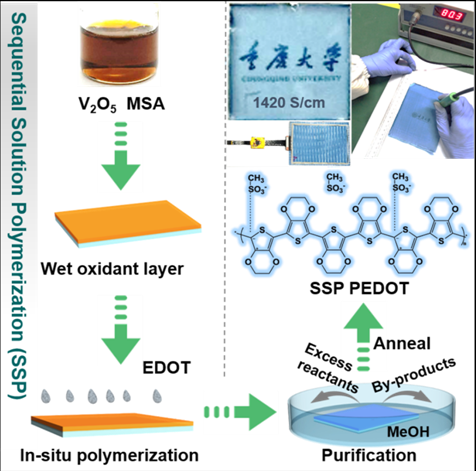The research team led by Researcher Sun Kuan from the School of Energy and Power Engineering, Chongqing University has recently developed an all-new conductive macromolecule thin film deposition technique in collaboration with a number of Chinese and foreign research teams with support of CQU-NUS Joint Lab of New Energy Materials and Devices. With this technology, a DEPOT thin film can quickly form by polymerization on different substrates. Its conductivity is three orders of magnitudes higher than commercial product PH1000 (Heraeus GmbH). This method is applicable to a number of printing processes and can be used for mass production of flexible transparent conductive films. The touch screens made of PEDOT thin film with flexible PET plastics as the substrate have extraordinary flexibility and toughness. Related research achievements have been recently published in iScience, a sub-journal of Cell, under the title “Sequential Solution Polymerization of Poly (3, 4-ethylenedioxythiophene) Using V2O5 as Oxidant for Flexible Touch Sensors”.

PEDOT is a high-conductivity, high-toughness and high-chemical-stability conjugated polymer. The above qualities make DEPOT a widely used material in transparency electrodes, electrochromism and electromagnetic shielding. Currently, many methods are used to synthesize DEPOT, including EP, OCVD and VPP. However, such synthesizing methods impose stringent requirements for substrates or control of temperature and intensity of pressure, and there will be various challenges and high costs if they are used for mass industrial production. As such, the development of conductive materials with mechanical flexibility using the solution process at a normal temperature and pressure is of both academic value and practical engineering significance.
Given this context, the research group led by Researcher Sun Kuan has developed a DEPOT in-situ synthesizing method of successive deposition of oxidizing agent solution and monomer solution. In this synthesis system, V2O5 is used as an oxidizing agent and methanesulfonic acid is used as a dopant. The two would dissolve into each other and form an oxidizing agent solution. The research group synthesized the PEDOT thin film by spin-coating deposition of the oxidizing agent solution and EDOT monomer solution successively on the glass substrate. This film has advantages including high DEDOT content (69%), satisfactory crystallinity and high doping level (with a carrier concentration of 2.6221 cm-3). Its electric conductivity can be as high as 1,420 S/cm. After that, the research group used the stick-type coating method to deposit oxidizing solution on the flexible PET substrate of 15 cm × 12 cm and then soak it into the monomer solution for polymerization. The flexible PEDOT thin film obtained this way has a sheet resistance of 80.3Ω/sq. Touch control devices made of such thin films with flexible PET as the substrate have outstanding sensitive properties and toughness. Even after repeated bending or even folding, they will still maintain satisfactory functionality. This all-new synthesizing path is not only compatible with stick-type coating method, and is also applicable to different printing processes including blade coating, silk-screen printing, spraying and reel-to-reel printing. It provides important ways of thinking and possibilities for synthesizing large-area even conductive macro-molecule film on flexible substrates.
The Project has been supported by the National Natural Science Foundation, the earmarked funds for key R&D projects of Chongqing, the Basic and Frontier Research Program of Chongqing, the International Student Entrepreneurship and Innovation Program of Chongqing, the basic scientific research operating expense for colleges and universities allocated by the central government and Key Lab of Low-grade Energy Utilization Technologies and Systems, MOE. Chen Rui, a postgraduate student of the School of Energy and Power Engineering is the first author. Researcher Sun Kuan of Chongqing University and Professor Ouyang Jianyong from the National University of Singapore are corresponding co-authors.
Link of the paper: https://www.cell.com/iscience/fulltext/S2589-0042(19)30003-3

